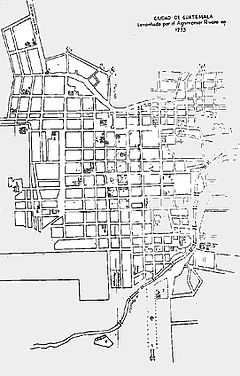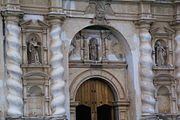
Antigua Guatemala, commonly referred to as just Antigua or la Antigua, is a city in the central highlands of Guatemala known for its preserved Spanish Baroque-influenced architecture as well as a number of ruins of colonial churches. It served as the capital of the Kingdom of Guatemala. It has been designated a UNESCO World Heritage Site.

The monumental complex of the Basilica and Convent of San Francisco of Lima, also known as "San Francisco el Grande" or "San Francisco de Jesús", is located in the Historic Center of Lima, Peru. This church together with the Sanctuary Nuestra Señora de la Soledad and the Church del Milagro set up one of the welcoming and artistic corners of Lima. Ramón Menéndez Pidal, Spanish philologist and scholar in this regard commented: "It is the largest and noblest monument that erected in these prodigious lands the conquest".
San Martín Jilotepeque is a town, with a population of 10,812, and a municipality in the Chimaltenango department of Guatemala. It was the site of a bus accident in 2013.

Peter of Saint Joseph de Betancur y Gonzáles (Spanish: Pedro de San José de Betancur y Gonzáles, March 21, 1626 – April 25, 1667, called Hermano Pedro de San José Betancurt or more simply Peter de Betancurt, Hermano Pedro, Santo Hermano Pedro, or San Pedro de Vilaflor, was a Spanish saint and missionary in Guatemala. Known as the "Saint Francis of Assisi of the Americas", he is the first saint native to the Canary Islands, is also considered the first saint of Guatemala and Central America for having done his missionary work in those American lands. He was the founder of Order of Our Lady of Bethlehem.
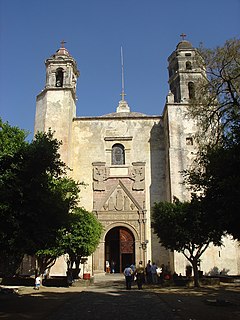
The Monasteries on the slopes of Popocatépetl are fifteen 16th-century monasteries which were built by the Augustinians, the Franciscans and the Dominicans in order to evangelize the areas south and east of the Popocatépetl volcano in central Mexico. These monasteries were recognized by the UNESCO as World Heritage Sites in 1994, because they served as the model for the early monastery and church buildings as well as evangelization efforts in New Spain and some points beyond in Latin America. These monasteries almost uniformly feature a very large atrium in front of a single nave church with a capilla abierta or open chapel. The atrium functioned as the meeting point between the indigenous peoples and the missionary friars, with mass for the newly converted held outdoors instead of within the church. This arrangement can be found repeated in other areas of Mexico as these friars continued to branch out over New Spain.
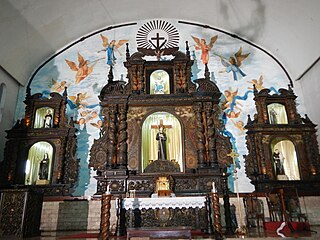
The Basilica Menor de San Pedro Bautista(Minor Basilica of Saint Pedro Bautista), also known as the San Francisco del Monte Church is a parish church in the San Francisco del Monte district of Quezon City, in the Philippines. It is one of the oldest churches in the country having founded in 1590. The church is dedicated to its founder Padre Pedro Bautista, a Spanish missionary from Ávila, Spain, one of the 26 Christians martyred in Japan in 1597.

The Roman Catholic Diocese of San Cristóbal de La Laguna, also called Diocese of Tenerife or Diocese Nivariense, is a diocese located in the city of San Cristóbal de La Laguna in the Canary Islands in the Ecclesiastical province of Sevilla in Spain. The diocese includes the islands of Tenerife, La Palma, La Gomera and El Hierro, in the province of Santa Cruz de Tenerife. The bishop of this diocese is Bernardo Álvarez Afonso.

Santo Domingo Church and Monastery is a ruined monastery in Antigua Guatemala, Guatemala. Its history can be traced back to 1538 when the Dominicans arrived in Guatemala. It had two towers with ten bells and the monastery was filled with treasures. The monastery was destroyed in the 1773 Santa Marta earthquake. Today, part of the ruins have been transformed into a hotel, the Hotel Casa Santo Domingo.

Antigua Guatemala Cathedral is a Latin Catholic church in Antigua Guatemala, Guatemala. The original church was built around 1541, but suffered several earthquakes throughout its history, and the first church building was demolished in 1669. The cathedral was rebuilt and consecrated in 1680. By 1743 the cathedral was one of the largest in Central America. However, the devastating 1773 Guatemala earthquake seriously damaged much of the building, though the two towers at the front remained largely intact. These have undergone restoration work, and the cathedral has been partly rebuilt
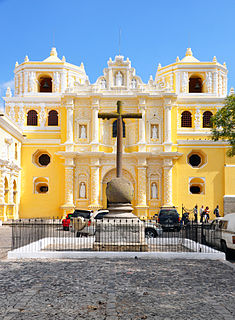
The Church and convent of La Merced is a Catholic temple located in the city of Antigua Guatemala in Guatemala. The architect Juan de Dios Estrada was in charge of its construction from 1749. The temple was inaugurated in 1767.
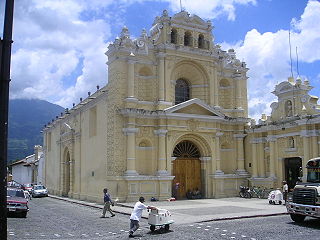
San Pedro is a hospital and adjacent church in Antigua Guatemala, Guatemala. It is dedicated to Peter of Saint Joseph Betancur.

The Iglesia y Convento de las Capuchinas is a notable convent and church in Antigua Guatemala, Guatemala. It is one of the finest examples of an 18th-century convent in Guatemala. It was consecrated in 1736 but like the rest of the city suffered damage during the 1751 and 1773 earthquakes respectively, and was abandoned by order of the Captain General at the time.
San Andrés Cholula Municipality is a municipality in Puebla in south-eastern Mexico. It forms part of the Metropolitan area of Puebla, and as of 2011, it is the fastest-growing municipality that conforms the Metropolitan Area, partly because the presence of universities and the wealthiest neighborhoods are located on San Andres Cholula. Along with San Pedro Cholula and Santa Isabel Cholula, it conforms the most ancient still inhabited city in the Americas, Cholula de Rivadabia.

The Holy Church Cathedral Metropolitan Basilica of Santiago de Guatemala also Metropolitan Cathedral, officially Catedral Primada Metropolitana de Santiago, is the main church of Guatemala City and of the Archdiocese of Guatemala. It is located at the Parque Central in the center of the city. Its massive structure incorporates baroque and classical elements and has withstood numerous earthquakes. Damage by the devastating earthquakes of 1917 and 1976 has been repaired. The inside of the cathedral is relatively sparsely decorated but impresses by its size and its structural strength. The altars are ornate and decorative. In front of the cathedral stand a series of 12 pillars, solemnly remembering the names of thousands of people forcibly disappeared or murdered during the counterinsurgency violence of Guatemala's internal armed conflict, which began in 1960 and lasted until the final peace accord was signed in 1996.

The Cuernavaca Cathedral is the Roman Catholic church of the Diocese of Cuernavaca, located in the city of Cuernavaca, Morelos, Mexico. The church and its surrounding monastery is one of the early 16th century monasteries in the vicinity of the Popocatepetl volcano inscribed as a World Heritage Site by UNESCO, built initially for evangelization efforts of indigenous people after the Spanish conquest of the Aztec Empire. By the 18th century, the church of the monastery began to function as the parish church of the city and in the late 19th century, it was elevated to the rank of a cathedral. Unlike many cathedrals in Mexico, this one does not face the city's main square, but rather is located just to the south, in its own walled compound, which it shares with a number of other structures. Unlike the other monastery structures from its time, the importance of this church provoked a number of renovation projects, the last of which occurred in 1957. This one took out the remaining older decorations of the interior and replaced them with simple modern ones. This renovation work also uncovered a 17th-century mural that covers 400 square metres (4,300 sq ft) of the interior walls and narrates the story of Philip of Jesus and twenty three other missionaries who were crucified in Japan.

La Recolección Architectural Complex is a former church and monastery of the Order of the Recollects and its adjacent park in Antigua, Guatemala. It is in the western part of the old city.

The Church and convent of the Society of Jesus in Antigua Guatemala is a religious complex that was built between 1690 and 1698. It was built on a block that is only 325 yards (300 m) away from the Cathedral of Saint James on a lot that once belonged to the family of famous chronicler Bernal Díaz del Castillo and had three monastery wings and a church. There were only a maximum of 13 Jesuit priest at any given time in the building, but they also hosted Jesuit brothers and secular students. In the building was the San Lucas School of the Society of Jesus, until the Jesuits were expelled from the Spanish colonies in 1767.

The Captain General Palace, or Palacio de los Capitanes Generales, is a large building localed in the Central Square of Antigua Guatemala. It serves as the headquarters of the Guatemala Institute of Tourism, the Antigua Tourism Association, National Police and the Sacatepquez Department government.
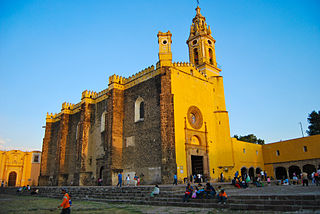
The San Gabriel Franciscan Convent or San Gabriel Friary is a church and friary in Cholula, Metropolitan area of Puebla City, Mexico.

